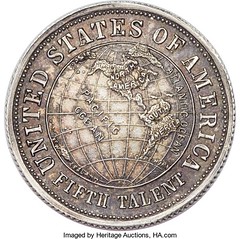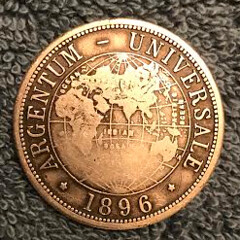
PREV ARTICLE
NEXT ARTICLE
FULL ISSUE
PREV FULL ISSUE
MORE ON 1896 ARGENTUM UNIVERSALE COINSLast week we reported a previously unknown example of the One Talent Argentum Universale proposed coinage pattern. Since then, Heritage has posted images of the One-Fifth Talent
piece in their upcoming sale. Here are images of the two coins. The One Talent is worn, perhaps from being a pocket piece. -Editor
    David Klinger kindly located and corrected OCR errors in this transcription of the original newspaper article referenced in the Heritage lot description. Thanks! -Editor
NEW IDEA IN COINAGE_______________
Mr. Greeff's Suggestion -Coins Made of an Alloy of one part gold to four parts Silver, Designed for use by all Nations. That a universal monetary standard, arrived at by international agreement, would be an immense boon to the commercial world is a matter which does not admit of argument. The difficulty arises with the question, "What shall that standard be?" "Gold!" cries the goldbug as soon as the question is put. "Silver!" shrieks the silver crank. "A union of both metals at a certain fixed ratio!" yells the bimetallist sharp. And so the discord goes on and harmony seems impossible. But now arises a fourth party with a new idea, which he thinks will meet the acquiescence of all thoughtful men. It is a species of bimetallism in the sense that it admits the use of both metals. But it has none of the dangers of a double standard which must result from any attempt to fix arbitrarily the relative value of two metals whose relations to each other are ruled only by the ever shifting law of demand and supply. Mr. Emil Greeff, an American citizen, born in Germany, but who has resided in country since 1860 and is at present the senior member of a large firm whose interests are on both sides of the Atlantic, is the originator of this new idea. Briefly put, he believes that the union of gold and silver in a single coin in a definite, unvarying proportion of weight and measure would solve the problem of a common money standard or measure of value. This coin could be used as a universal legal tender, with which all international debts could be liquidated. Mr. Greeff believes that all these excellent results could be achieved by an alloy containing one part gold to four parts silver. The universal legal tender unit would be a coin containing one-fifth of an ounce of gold and four-fifths of an ounce of silver. This coin he calls tentatively a talent. The hundred multiple thereof he calls a great talent. One ounce of pure gold is worth about $20.07, or one-fifth part of it very nearly $4. 14. The present market value of one ounce of silver is about 67 cents, or four-fifths of an ounce a little over 03 cents, making a total of $4.07 as the present market value of a talent. He points out that in the talent we would have a unit that would always retain its gold value of $4.14, even should the value of silver total disappear which, however, is not very likely. The legal tender qualification alone would certainly increase the value of tho silver contained in it. If, on the other hand, silver should rise to its former value of 16 to 1, the talent may increase in commercial worth to about $5. 17. It is apparent that a talent therefore comes very near in value to: One American half eagle, $5, as against $4.67.
One-fifth of a talent would, at the current value of gold and silver, be worth in our money 93 2/5 cents. A coin could be struck to represent one fifth of a talent. This would be used as the future trade dollar. It would be analogous to 4 shillings in English money, 4 marks in German money or 5 francs in French money. In order to see exactly how a coin made of the proposed alloy would look, Mr. Greeff employed a jeweler to make a one talent coin and a fifth of a talent coin. He showed me the coins when I called upon him the other day. The first is a trifle smaller than a silver dollar, the other exactly the size of a silver quarter. The weight is respectively one ounce and one-fifth of an ounce. The trifling surplus is copper, to give the coin a better ring. Both coins have hemispheres engraved on either side, the obverse bearing the inscription, "Argentum Universale, 1896," the reverse, "United States of America," and "One Talent" and "One-Fifth of a Talent" respectively. ----New York Herald So we learn from this article the name of the inventor of the proposed coinage, Emil Greeff. An internet search located a few references to Greeff. Perhaps more information will turn
up. Can readers locate more about him? -Editor
To read other Emil Greeff internet references, see:
Recently-added sources in the Newman Numismatic Portal show that the Argentum Universale pieces have appeared in some auction sales over the years. -Editor
Stack's January 18, 1989, Stanley Simon sale, lot 675, One Talent, Choice Brilliant Uncirculated. "The pieces are quite rare; we can only recall seeing three in the past decade or so." Realised $341. Stacks Bowers, John J. Ford sale, Part 23, August 16, 2013, lots 22007 (One Talent, MS-65 Uncertified, ex-F.C.C. Boyd) and 22008 (Fifth Talent, MS-65 Uncertified, ex-F.C.C. Boyd). Realized $3055 and $646.25, respectively. David Klinger provided this excerpt from Vassar's web site of 1896 political cartoons for historical background on bimetallism in the context of the politics of the day. Thanks!
-Editor
The Gold Standard, Bimetallism, or 'Free Silver'? The bitter controversy surrounding the issues of "free silver" and "sound money," so central to the 1896 campaign, has proved difficult for historians to explain. Partisans on both sides made exaggerated claims of the impact monetary policy could have on the nation's economic health. They implied that coinage of silver (on Bryan's side) or adherence to the gold standard (on McKinley's side) was the single key to prosperity--and sometimes to the nation's honor. Oddly, before 1896 both McKinley and Bryan had focused more attention on the tariff than on currency issues. Despite his party's platform, McKinley sought to emphasize the tariff and to avoid being labelled a "monometallist" or "bimetallist," leading to accusations of waffling. While he was a Congressman, Bryan allegedly once said that "the people of Nebraska are for free silver, so I am for free silver. I will look up the arguments later." His 1896 campaign became a free silver crusade. Since the Civil War , a series of third parties had criticized Republicans' policy of contracting the money supply. Lincoln's issue of Greenbacks, the first national paper money, had helped finance the war but it also stimulated inflation. In subsequent decades, national Republican leaders sought to withdraw the greenbacks until each dollar had 100% backing in metal reserves. During the economic depressions of the 1870s and 1890s, in particular, this policy was roughly opposite to that which today's Federal Reserve might pursue in an economic downturn. It drew criticism as tending to favor bankers and lenders--who needed the value of a borrowed dollar to hold steady, or increase, until it was repaid--and detrimental to borrowers and workers. Heirs to the Greenback Party of the 1870s believed that paper money was the solution. In post-war decades, however, the opening of vast silver veins (such as Nevada's Comstock Lode) had sharply increased the nation's silver supply. To Silver Democrats, federal coinage of silver (at a weight ratio of 16 ounces to 1 ounce of gold, hence the slogan "16 to 1") was a moderate solution to the currency problem. After all, silver was a precious metal, not mere paper. "Free silver" thus temporarily allowed a spectrum of currency reformers--from Southern Democrats to Populists--to unite. To horrified Gold Democrats and Republicans, "free silver" was an appeal for cheaper dollars. It would cheat lenders of an honest return on their money, allowing profligate borrowers to steal value from those who had extended loans. Free silver at "16 to 1" would have expanded the money supply, but as a lone measure it would hardly have solved the nation's economic woes, and it would have (as Republicans argued) substantially raised the value of silver in relation to gold. Yet adherence of 'sound money' was not solely--or even primarily--responsible for the country's return to prosperity after 1896. To the extent that McKinley's victory reassured investors and financial institutions, whose leaders were frightened of Bryan, resolution of the issue may have had an indirect economic impact. After the campaign, however, the currency question faded quite rapidly from political debate. To read the complete article, see:
To read the earlier E-Sylum article, see:
 Wayne Homren, Editor The Numismatic Bibliomania Society is a non-profit organization promoting numismatic literature. See our web site at coinbooks.org. To submit items for publication in The E-Sylum, write to the Editor at this address: whomren@gmail.com To subscribe go to: https://my.binhost.com/lists/listinfo/esylum All Rights Reserved. NBS Home Page Contact the NBS webmaster 
|